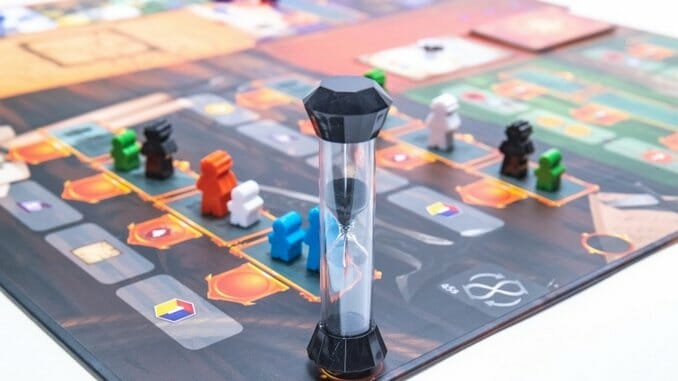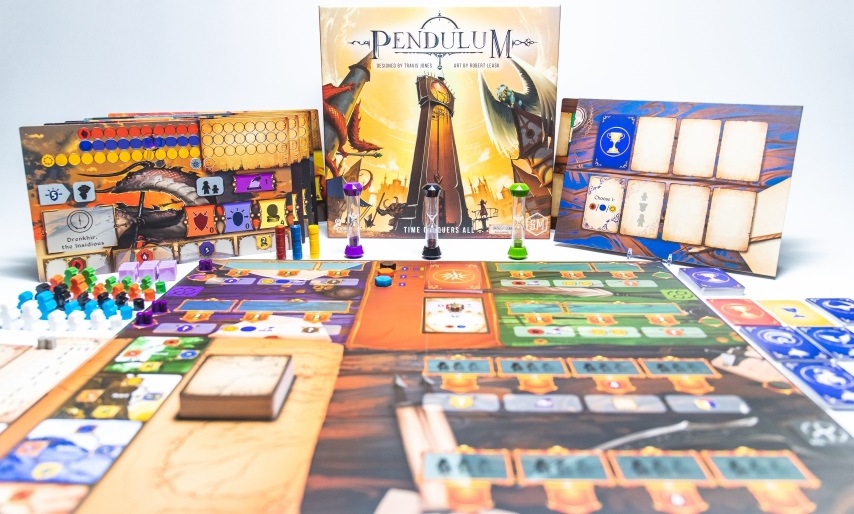The Unique Pendulum Is an Ingenious Board Game
Images courtesy of Stonemaier Games
Pendulum is unlike any game I’ve played before, a worker placement and engine-building game without turns, determining the length of rounds and the entire game via the use of three timers of different durations that also dictate where you can place your meeples on the board. It has a pretty high learning curve for a game that’s not actually very complex under the hood, and I have some real complaints about the color choices in the game, but once you get rolling it’s an ingenious game that moves along well enough to keep everyone’s attention.
In Pendulum, players try to gain points on three victory tracks on their individual player mats, with each mat showing different combinations of track lengths so no two players have the same goals. To gain those points, you’ll place your two workers, one small and one large (grande), on the board, which has three areas and multiple places to go in each area, to gain the game’s three resources, to directly gain points, or to collect ‘votes.’ Each player also begins with a hand of four cards that they can play at any time, gaining a free resource, gaining a victory point, or paying to acquire another worker meeple.
Where you go on the board is determined by the placement of the game’s three timers. Each section has two rows of action spaces, and when a timer is next to a row, you can use the actions there if you had a meeple on one of its spaces, but you can’t place new meeples there or move any who were already on those spaces (or who just completed their actions). When a timer runs out, any player may take it, flip it, and place it on the other row in that section, which means meeples in that second row can use their actions, while meeples on the now-vacated role can be moved elsewhere on the board. The three timers all have different durations—45 seconds for black, two minutes for green, three minutes for purple—so you can use the spaces in the black section more frequently than those in the other two, but of course the black section’s actions are less powerful.

Some actions allow you to use one of the four province powers shown on your player mat, which involve collecting 4/5/2 red/blue/yellow resources, or gaining one red victory point. Over the course of the game, however, you can add to those powers by paying four resources to gain province cards, which have additional bonuses on all four sides; you rotate it to choose the bonus you want and put it under the slot matching the background color on the scroll on that side of the card. When you use that action on the board again, you’ll get the base bonus plus all bonuses on province cards in that section.
That’s the main use for red resources in the game, while using some action spaces requires payment of two gold resources, and spending five blue resources allows you to refresh your hand by picking up all cards you’ve already played and discarded. The votes are a different resource, the primary function of which is to determine which player will gain privilege in the next round. (My daughter pointed out that the highest privilege obviously belongs to the player with the white meeples.) Privilege matters when two players want to use the same space with their smaller workers, which can only be placed where there are no other meeples, and determines the selection order of new cards at the end of each round, some of which go into your hands and some of which offer significant one-time benefits.
Each round also has a “legendary achievement” card that serves two purposes. Any player who meets the criteria on the card, owning a minimum of resources and votes, gets the bonus at the bottom. The first player to do so in each round gets to move their grey point tracker one space to the right, which is a requirement to win, although you can only do this once in the game. It’s a strange quirk, not well integrated with the rest of the rules, but does provide a secondary function for all the resources and votes you’ll gather in the course of regular game play.
Pendulum is the latest title from Stonemaier Games, publisher of Wingspan, Charterstone, and Scythe, so the components are all very high-quality and you can see that the rules were extensively playtested, with discussions in the rulebook that cover a lot of possibilities (like forgetting to use workers when timers flip, a pretty easy mistake to make). It’s surprising, then, that some of the art choices, including color selections, are such a problem—the brown province symbols are not easy to distinguish from the gold on the board, or from the red on your player mats, and every one of us put at least one province in the wrong place and/or tried to use the wrong action on the board as a result. The little scroll symbols used to denote those actions are too small, with the color of the scrolls on the province cards obscured by the icons showing the bonuses you get for activating them. It’s a serious flaw and a good argument for playing without the timers for your first few plays, until checking the colors of those scrolls becomes second nature.
There is a lot to explore here, as you can build up your player mat by adding provinces and creating a little engine that lets you gain resources and points quickly enough to make use of the more powerful action spaces in the green and black areas. That makes Pendulum a high cognitive load game, even though it’s not that complex—you will always have a lot of things on your mind, not least of which is keeping an eye on all your workers so you don’t lose track of them and forget to move them when they’re free. (I wouldn’t try to play this while drinking!) It’s going to be tough to teach, even to people who’ve played a few Eurogames, because the whole idea of a turnless game with timers that restrict your movement is novel—but that’s also what makes Pendulum so interesting, and why I think it’ll have a lot of replay value over many sessions once you get the hang of it.
Keith Law is the author of The Inside Game and Smart Baseball and a senior baseball writer for The Athletic. You can find his personal blog the dish, covering games, literature, and more, at meadowparty.com/blog.